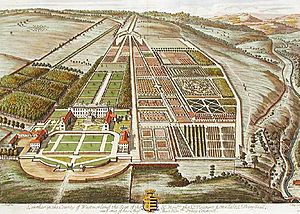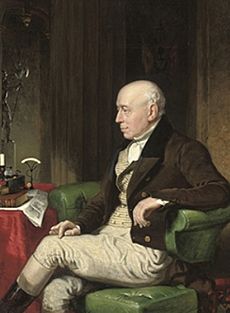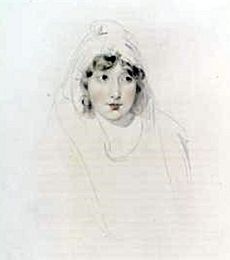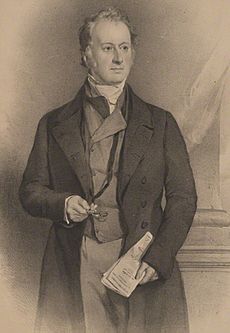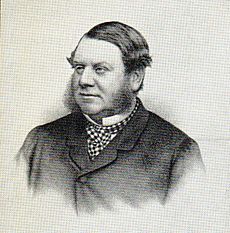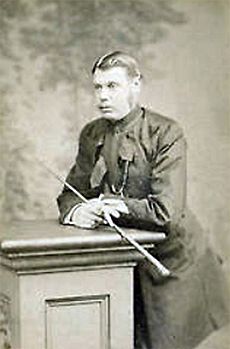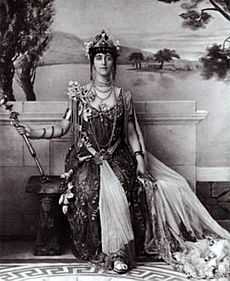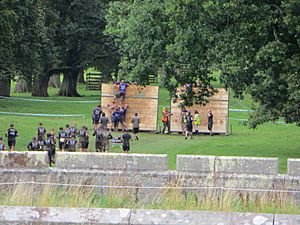Lowther Castle facts for kids
Lowther Castle is a grand country house in Cumbria, England. It has been owned by the Lowther family for many centuries. Today, it is a managed ruin, meaning its walls are still standing, but it doesn't have a roof.
Visitors can explore the castle's shell and some of its beautiful gardens. It first opened to the public in 2011. Since then, more work has been done to restore the extensive gardens.
In 1568, Mary, Queen of Scots visited Lowther Castle. She was on her way to other places like Wharton Hall and Bolton Castle.
In the late 1600s, John Lowther, 1st Viscount Lonsdale rebuilt the family home. It was known as Lowther Hall back then. The building you see today is a large, castle-like mansion. It was built by Robert Smirke for William Lowther, 1st Earl of Lonsdale. This happened between 1806 and 1814. It was only then that the place was called a "castle."
The family's money ran low because of the spending habits of the 5th Earl of Lonsdale. He was a very famous person in society. The castle closed in 1937. During the Second World War, it was used by a tank army. Its valuable items were taken out in the late 1940s. The roof was removed in 1957. The Lowther Estate Trust still owns the castle's shell.
In 1793, George Macartney, 1st Earl Macartney visited the Chinese emperor's summer home. He said it was as magnificent as Lowther Hall. He wrote that Lowther Hall had amazing views, grand surroundings, and beautiful woods. He thought it could be the finest place in Britain.
In the 1800s, an East India Company ship was named HCS Lowther Castle.
Contents
The Story of Lowther Castle
William Lowther, 1st Earl of Lonsdale
William Lowther was born in 1757. He was about 52 years old when he started building Lowther Castle. He was the oldest son of Reverend Sir William Lowther. William went to Cambridge University. In 1780, at age 23, he became a Member of Parliament (MP).
A year later, he married Lady Augusta Fane. She was the daughter of the 9th Earl of Westmorland. William was an MP for 22 years. In 1802, he inherited the family estates from his cousin, Sir James Lowther.
Sir James Lowther had some financial issues. He owed money to the father of the famous poet William Wordsworth. Sir James refused to pay it. When William inherited the fortune in 1802, he immediately paid the money back to the Wordsworth family. He even added interest. William also became friends with William Wordsworth and helped him with money. Wordsworth often stayed at Lowther Castle. Many of his letters were written from there.
Wordsworth wrote several poems for William. Here is a part of his poem about Lowther Castle: "Lowther! in thy majestic Pile are seen
Cathedral pomp and grace in apt accord
With the baronial castle’s sterner mien"
Lady Augusta Lonsdale, William's wife, also supported artists. She kept an album where visiting poets wrote verses. Wordsworth wrote a long poem for her in this album.
Robert Southey, another famous poet, also visited the castle often. He wrote in Lady Lonsdale's album too. Here is a verse he wrote about Lowther Castle: "Lowther! have I beheld thy stately walls,
Thy pinnacles, and broad embattled brow,
And hospitable halls.
The sun those wide spread battlements shall crest,
And silent years unharming shall go by,
Till centuries in their course invest
Thy towers with sanctity."
The Earl and Countess also invited artists to Lowther Castle. The most famous was Joseph Turner. He painted "Lowther Castle – Evening." This painting is now in the Bowes Museum. William also supported Jacob Thompson, who painted his portrait.
In 1839, Mrs. Harriette Story Paige visited Lowther Castle. She came with Daniel Webster, a famous American politician. She wrote about her visit in her diary. She noted that they arrived at lunch time. She also mentioned the castle bell ringing as they drove through the park. Daniel Webster's wife also wrote about her visit to Lowther Castle in her diary.
William Lowther, 2nd Earl of Lonsdale
William Lowther, the 2nd Earl of Lonsdale, was born in 1787. He went to Harrow School and Cambridge University. In 1808, he followed his father and became a politician. He was an MP for 33 years until 1841. In 1844, when his father died, he inherited the Lowther Estates.
William did not marry or have legitimate children. When he died in 1872, the Lowther Estates went to his nephew, Henry Lowther.
Henry Lowther, 3rd Earl of Lonsdale
Henry Lowther was 54 years old when he inherited the Lonsdale Estates. He died just four years later from pneumonia. So, he did not have much time to change Lowther Castle.
Henry was born in 1818. He was the nephew of the 2nd Earl of Lonsdale. His mother was Lady Lucy Sherard. He went to Westminster School and Cambridge University. In 1841, he joined the 1st Life Guards, a military regiment. He was also a Member of Parliament for West Cumberland from 1847 to 1872.
In 1852, he married Emily Susan Caulfield. They had six children. When Henry died in 1878, his son St George Lowther inherited the estates. St George became the 4th Earl of Lonsdale.
St George Lowther, 4th Earl of Lonsdale
St George was born in 1855. He was only 23 when he inherited Lowther Castle. He loved exploring. When he got his fortune, he spent much time on his two steam yachts. He traveled to faraway parts of the world. He was interested in the sea. His studies of the Gulf Stream were important. They were even published by the American Hydrological Department.
In 1878, he married Lady Gladys Herbert. She was a very famous person in society. People said she was "superbly beautiful." She was tall, with dark eyes and bright coloring.
Their marriage was not very successful. St George was often away traveling. Gladys enjoyed a social life that he did not approve of. Gladys often hosted guests at Lowther Castle. One of her visitors was Lillie Langtry. Langtry wrote about her stay at Lowther Castle. She said Gladys met her at Carlisle Station with a pony car. Langtry also mentioned seeing an emu walking around the grass at the castle.
In 1882, at age 26, St George died after a short illness. His younger brother, Hugh Cecil Lowther, inherited the castle.
Hugh Lowther, 5th Earl of Lonsdale
Hugh Cecil Lowther was born in 1857. He was only 25 when he inherited the castle. As the second son, he did not expect to manage an estate. He left Eton school at age 12 and spent his time playing sports.
In 1878, Hugh married Lady Grace Gordon. Her family did not approve because Hugh was not wealthy and seemed irresponsible. They were right. The next year, he invested a lot of money in cattle in America. The business failed, and the Lowther family had to help him.
The couple lived near Oakham. Grace became pregnant but had an accident while hunting. After this, they had no children. She was not well for the rest of her life.
After inheriting his fortune in 1882, Hugh spent a lot of money on his hobbies. He bought many horses and carriages. He had servants in yellow uniforms, a chamberlain, and a music master. This person supervised 24 musicians who traveled with him. His household traveled in a special train. Hugh said he was the last of the Lowthers because he had no children. However, his younger brother Lancelot would inherit the estate, though it would be much smaller.
In August 1895, the Kaiser (German Emperor) visited Lowther Castle for grouse hunting. The imperial flag flew over the house. The kings of Italy and Portugal also stayed there later. The Kaiser visited a second time in 1902. The Kaiser gave Lonsdale a special award and a Mercedes car. Hugh loved cars and became the first President of the Automobile Association. He was also the first president of the International Horse Show. In 1920, the Horse Show arena was decorated to look like the gardens at Lowther Castle.
During the First World War, Hugh helped start the Blue Cross. He also helped recruit men and horses for the war. He had his own army group called the Lonsdale battalion. This battalion was almost completely lost in the Somme.
After the war, Hugh stopped hunting. He became more involved with race horses. He became a senior leader of the Jockey Club. He had only one major win, the St Leger race in 1922. He was rarely seen in the House of Lords.
Because of his huge spending, he had to sell some of his properties. In 1921, Whitehaven Castle was sold. In 1926, Barleythorpe was sold. The same year, the west Cumberland coal mines closed. In 1935, he left Lowther Castle because he could no longer afford to live there. He moved to a much smaller home. Grace died in 1941, and Hugh died three years later in 1944, at age 87.
Lowther Castle Closes Its Doors
In 1939 or 1940, the castle was taken over for the war effort. It was used for developing tanks. It was returned to the family, but not until 1954. The family could not afford to use or maintain it. They offered to give it to the National Trust and other groups. But in those difficult years after the war, no one wanted it. To avoid taxes, they took out the castle's contents and removed the roof.
Hugh Lowther was the last person to live at Lowther Castle. His brother Lancelot, the 6th Earl, inherited the estate in 1944. But because of Hugh's large debts, Lancelot had to sell many family treasures. A big auction was held in 1947. Lancelot died in 1953. His grandson, James, took over.
James wanted to improve the estates. He focused on farming. He saw Lowther Castle as too expensive. After returning from World War II, he felt it was too grand for the times. The army had damaged the grounds and buildings during the war. The castle had been empty for many years. James offered the castle as a gift to three local authorities, but they all said no. Back then, big country houses either had to open to the public or be torn down. Facing huge taxes, he could not afford to open it. So, he decided to remove the roof and much of the stonework. Only the front and outer walls remained.
The front courtyard became pig pens. The concrete the army had laid on the south lawns was used for a chicken factory. The rest of the gardens became a timber plantation with Sitka spruce trees.
Many improvements have happened since then. After Lord Lonsdale died in 2006, the chicken factory and trees were removed. With a lot of money from different sources, some gardens were restored. The castle shell was also repaired, and the stables were fully fixed up.
Reopening Lowther Castle
After an initial £9 million restoration, the castle and some gardens opened to the public in 2011. This was the first time since 1938. Other garden areas were still overgrown then.
In 2016, the Lowther family started managing the property again. This was before the official reopening for the 2017 season. A report in 2018 said that the partly ruined castle and damaged garden had been brought back to life. Lowther is now one of the top places to visit in Cumbria. In the same year, it won the Large Visitor Attraction of the Year 2018 award.
By mid-2019, the TripAdvisor website had over 1,000 reviews for Lowther Castle. It had an average rating of 4.5 stars. The site mentioned a great benefit for younger visitors: an "adventure playground in the woods."
The Lost Gardens of Lowther Castle
The gardens of Lowther Castle were left to grow wild in 1935. But before that, they were beautiful. Many generations of the Lowther family carefully tended them. There is a detailed description of the gardens from when the 5th Earl lived at the Castle. This description helps us imagine how they looked.
Gardens on the Western Side
Behind the Terrace, you would find the Rock Garden. Lady Lonsdale especially loved this garden. It was known for its unique collection of Alpine plants. It also had Japanese dwarf maples that turned scarlet and crimson in autumn. Many climbing plants grew over rustic arbours. Rustic bridges crossed its water lily ponds.
Nearby, hidden by almost invisible paths, was the Sweet Scented Garden. This garden was special. It was an oval shape surrounded by tall, dark shrubs. All kinds of sweet-smelling flowers grew here. They were in round and oval beds in the center. Scented lilies were in the middle of each bed. Around the edges were rustic seats in honeysuckle arbours. Between them were pools fed by tiny waterfalls. These water features are still there today.
In the center bed was an old French vase. It was originally from a house in Germany. Lord Lonsdale admired it when he was there. Lines from a poem were carved around it. The Kaiser himself gave this vase to Lord Lonsdale as a gift. Lord and Lady Lonsdale often came to this garden after dinner. They would sit and enjoy its scents and quiet.
Close by, and also hidden, was the Japanese Garden. It had Chinese and Japanese decorations. There were life-size bronze birds and animals. It also had Japanese shrines and dwarf trees. Scarlet lacquer dwarf bridges crossed miniature lakes. These lakes were filled with Japanese water-lilies and iris. Tiny islands and hidden paths completed the garden.
Beyond the Japanese Garden was the Rose Garden. It had about 25,000 rose bushes. Rambler rose tents were in all four corners. The bushes were planted on green grass. A fountain and small rockery were in the center. The remains of this fountain are still in the garden today. Leading out of the Rose Garden was an Iris Garden. It was enclosed by a trimmed hedge. It had more lily ponds with stone seats and lead figures.
The Japanese Garden was created in 1904 by a local gardener named Thomas Richard Hayes. He was an expert in rock and water garden design. Hayes brought trees from Japan. He used pools, curved bridges, and statues of water birds to make it feel truly Japanese.
The Terrace
The Terrace is one of three natural terraces at Lowther. These were formed long ago by land sinking. The rocks and boulders were left bare. It lies a bit to the south-west of the castle. It has been covered with grass and faced with stone on the drop side. This was to keep deer and cattle out. The artificial part of this area is about a mile long. It is bordered by trees and shrubs on the garden side.
From this terrace, the views of the mountains are amazing. Below, the River Lowther winds through the landscape. Sometimes it flows over shallow areas and rapids. There are also deep pools. Stone hump-backed bridges cross the river. Between the river and Hawes Water are rolling hills. Looking slightly left, you can see for miles over the park to the fells. Lord Lonsdale and his brother Lancelot built a large rustic summer-house in the center of the terrace. It has an old water clock from one of the former Lowther houses. It has the words "Night cometh" carved on it.
Gardens to the East of the Castle
"Hugh's Garden" was designed by Lord Lonsdale himself. This was just before the First World War. It is a beautiful design, inspired by the gardens at Versailles in France. Six wide grass paths spread out like spokes of a huge wheel. They start from a high point south-east of the castle and get wider as they go down the slope.
Tall yew hedges divide the paths. These hedges are beautifully trimmed. They are shaped into strange forms at intervals along the top. There are two miles of these hedges. Beds along their base were planted with thousands of flowers. They created a blaze of color from early spring to late autumn. Some lovely old Italian well-heads made of carved stone are placed here and there. The idea for this garden was entirely Lord Lonsdale's own. From the center of this wheel, the views are almost as good as from the Terrace.
Close to Hugh's Garden is Jack Crofts Pond. It was originally a place for cattle to drink. Now, it is a charming ornamental body of water.
Conservation and Future
In 2000, the Lowther Estate and English Heritage worked together. They hired experts to look at the castle and its grounds. They created the Lowther Castle & Garden Conservation Plan. In 2005, the estate teamed up with other groups. These included the Northwest Development Agency, English Heritage, and the Royal Horticultural Society. Their goal was to fix up the site. They wanted to make the ruin safe, restore the 50-acre garden, and open the site to the public.
The castle and 130 acres of grounds were given to a charity in 2007. This charity is called the Lowther Castle and Gardens Trust. The site opened to the public on April 22, 2011. In March 2016, the property was leased to Lowther Castle Limited. This company manages the castle and gardens.
Work on the gardens continues. In summer 2016, "The Lost Castle" opened. This is the largest wooden playground in the country. It was built by hand using 11 miles of wood from sustainable sources. Work on the 130-acre garden was still going on in mid-2019. Plans were made by Patrick James and Dominic Cole. Designer Dan Pearson and the current owner, Jim Lowther, guided the work.
One project is the Garden in the Ruin. This is a new phase after plantings in 2015. It includes plants like Hydrangea aspera Sargentiana. The new Rose Garden already has 1,250 eglantine roses. In spring 2019, 6,000 more plants were added. These included white Geraniums and Narcissus flowers.
In late 2019, over 2,250 David Austin roses will be planted. Future plans include adding Japanese plants to The Japanese Garden. The Scented Garden will become Katsura Grove. The area around an old summer house will be planted with honeysuckle, roses, and bulbs. The updated gardens will open to visitors in spring 2020.
Events at Lowther Castle
Lowther Deer Park hosts fun events. These include the music festival Kendal Calling. It also hosts Born Survivor, a 10-kilometer obstacle course race.
|




